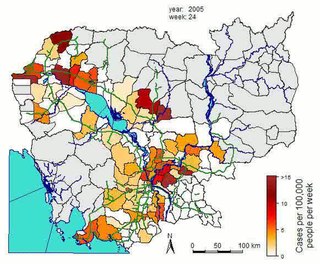Related Research Articles

Epidemiology is the study and analysis of the distribution, patterns and determinants of health and disease conditions in a defined population.

In epidemiology, incidence is a measure of the probability of occurrence of a given medical condition in a population within a specified period of time. Although sometimes loosely expressed simply as the number of new cases during some time period, it is better expressed as a proportion or a rate with a denominator.
The science of epidemiology has matured significantly from the times of Hippocrates, Semmelweis and John Snow. The techniques for gathering and analyzing epidemiological data vary depending on the type of disease being monitored but each study will have overarching similarities.

Environmental health is the branch of public health concerned with all aspects of the natural and built environment affecting human health. In order to effectively control factors that may affect health, the requirements that must be met in order to create a healthy environment must be determined. Environmental health focuses on the natural and built environments for the benefit of human health. The major sub-disciplines of environmental health are environmental science, toxicology, environmental epidemiology, and environmental and occupational medicine.
Pathogenesis is the process by which a disease or disorder develops. It can include factors which contribute not only to the onset of the disease or disorder, but also to its progression and maintenance. The word comes from Greek πάθος pathos 'suffering, disease' and γένεσις genesis 'creation'.
In epidemiological research, recall bias is a systematic error caused by differences in the accuracy or completeness of the recollections retrieved ("recalled") by study participants regarding events or experiences from the past. It is sometimes also referred to as response bias, responder bias or reporting bias.

The Epidemic Intelligence Service (EIS) is a program of the U.S. Centers for Disease Control and Prevention (CDC). The modern EIS is a two-year, hands-on post-doctoral training program in epidemiology, with a focus on field work.
Landscape epidemiology draws some of its roots from the field of landscape ecology. Just as the discipline of landscape ecology is concerned with analyzing both pattern and process in ecosystems across time and space, landscape epidemiology can be used to analyze both risk patterns and environmental risk factors. This field emerges from the theory that most vectors, hosts and pathogens are commonly tied to the landscape as environmental determinants control their distribution and abundance. In 1966, Evgeniy Pavlovsky introduced the concept of natural nidality or focality, defined by the idea that microscale disease foci are determined by the entire ecosystem. With the recent availability of new computing technologies such as geographic information systems, remote sensing, statistical methods including spatial statistics and theories of landscape ecology, the concept of landscape epidemiology has been applied analytically to a variety of disease systems, including malaria, hantavirus, Lyme disease and Chagas' disease.

The UCLA Jonathan and Karin Fielding School of Public Health is the graduate school of public health at UCLA, and is located within the Center for Health Sciences building on UCLA's campus in the Westwood neighborhood of Los Angeles, California. The UCLA Fielding School of Public Health has 690 students representing 25 countries, more than 11,000 alumni and 247 faculty, 70 of whom are full-time.

Avian malaria is a parasitic disease of birds, caused by parasite species belonging to the genera Plasmodium and Hemoproteus. The disease is transmitted by a dipteran vector including mosquitoes in the case of Plasmodium parasites and biting midges for Hemoproteus. The range of symptoms and effects of the parasite on its bird hosts is very wide, from asymptomatic cases to drastic population declines due to the disease, as is the case of the Hawaiian honeycreepers. The diversity of parasites is large, as it is estimated that there are approximately as many parasites as there are species of hosts. Co-speciation and host switching events have contributed to the broad range of hosts that these parasites can infect, causing avian malaria to be a widespread global disease, found everywhere except Antarctica.
Hematodinium perezi is an internal dinoflagellate parasite that infects crustaceans, including blue crabs, and causes bitter crab disease. Other crustaceans that have been observed to be infected include the Norway Lobster and King Crab, and has been observed to have a significant impact on crustacean fisheries. Infected crabs frequently show signs of weakness and lethargy, and often die due to stress-related handling from fishing as well as metabolic exhaustion due to reduced feeding. This parasite is known to be transmitted between alternate crustacean hosts, through the sharing of water and with the feeding of crabs on infected crabs.
Genetic epidemiology is the study of the role of genetic factors in determining health and disease in families and in populations, and the interplay of such genetic factors with environmental factors. Genetic epidemiology seeks to derive a statistical and quantitative analysis of how genetics work in large groups.
Neuroepidemiology is a science of incidence, prevalence, risk factors, natural history and prognosis of neurological disorders, as well as of experimental neuroepidemiology, which is research based on clinical trials of effectiveness or efficacy of various interventions in neurological disorders.

Eric Liang Feigl-Ding is an American public health scientist who is currently an epidemiologist and Chief of COVID Task Force at the New England Complex Systems Institute. He was formerly a faculty member and researcher at Harvard Medical School and Harvard T.H. Chan School of Public Health. He is also the Chief Health Economist for Microclinic International, and co-founder of the World Health Network. His research and advocacy have primarily focused on obesity, nutrition, cancer prevention, and biosecurity.
Clinical epidemiology is a subfield of epidemiology specifically focused on issues relevant to clinical medicine. The term was first introduced by Jean Paul in his presidential address to the American Society for Clinical Investigation in 1938. It is sometimes referred to as "the basic science of clinical medicine".
An infection rate is the probability or risk of an infection in a population. It is used to measure the frequency of occurrence of new instances of infection within a population during a specific time period.
Filicollis anatis is an endoparasite in the Polymorphidae family of thorny-headed worms. Adults have been found to occur in waterbirds such as ducks, where they cause a condition known as filicollosis. Larval stages occur in invertebrate hosts such as crayfish.

Kirsten Tackmann is a German politician. Born in Schmalkalden, Thuringia, she represents The Left. Kirsten Tackmann has served as a member of the Bundestag from the state of Brandenburg since 2005.

Janina Oyrzanowska-Poplewska was a Polish academic and veterinarian. A professor at the Warsaw University of Life Sciences, she specialized in epizootiology but her main area of research concerned viral diseases of canines, which led to the development of the first vaccine for canine distemper in Poland.
Jeffrey Salloway is a scientist and politician, currently serving as a representative for Strafford County's 5th District in the New Hampshire House of Representatives. Previously, he was a professor of Epidemiology at New Hampshire University. He is currently a Professor Emeritus.
References
- ↑ Shapiro-Ilan, David I.; Bruck, Denny J.; Lacey, Lawrence A. (2012-01-01). "Chapter 3 - Principles of Epizootiology and Microbial Control". In Vega, Fernando E.; Kaya, Harry K. (eds.). Insect Pathology (Second ed.). San Diego: Academic Press. pp. 29–72. doi:10.1016/b978-0-12-384984-7.00003-8. ISBN 9780123849847.